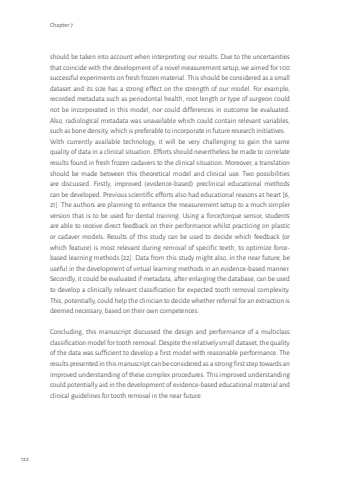Page 124 - Demo
P. 124
Chapter 7122should be taken into account when interpreting our results. Due to the uncertainties that coincide with the development of a novel measurement setup, we aimed for 100 successful experiments on fresh frozen material. This should be considered as a small dataset and its size has a strong effect on the strength of our model. For example, recorded metadata such as periodontal health, root length or type of surgeon could not be incorporated in this model, nor could differences in outcome be evaluated. Also, radiological metadata was unavailable which could contain relevant variables, such as bone density, which is preferable to incorporate in future research initiatives. With currently available technology, it will be very challenging to gain the same quality of data in a clinical situation. Efforts should nevertheless be made to correlate results found in fresh frozen cadavers to the clinical situation. Moreover, a translation should be made between this theoretical model and clinical use. Two possibilities are discussed. Firstly, improved (evidence-based) preclinical educational methods can be developed. Previous scientific efforts also had educational reasons at heart [6, 21]. The authors are planning to enhance the measurement setup to a much simpler version that is to be used for dental training. Using a force/torque sensor, students are able to receive direct feedback on their performance whilst practicing on plastic or cadaver models. Results of this study can be used to decide which feedback (or which feature) is most relevant during removal of specific teeth, to optimize forcebased learning methods [22]. Data from this study might also, in the near future, be useful in the development of virtual learning methods in an evidence-based manner. Secondly, it could be evaluated if metadata, after enlarging the database, can be used to develop a clinically relevant classification for expected tooth removal complexity. This, potentially, could help the clinician to decide whether referral for an extraction is deemed necessary, based on their own competences. Concluding, this manuscript discussed the design and performance of a multiclass classification model for tooth removal. Despite the relatively small dataset, the quality of the data was sufficient to develop a first model with reasonable performance. The results presented in this manuscript can be considered as a strong first step towards an improved understanding of these complex procedures. This improved understanding could potentially aid in the development of evidence-based educational material and clinical guidelines for tooth removal in the near future.Tom van Riet.indd 122 26-10-2023 11:59


